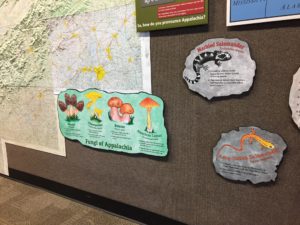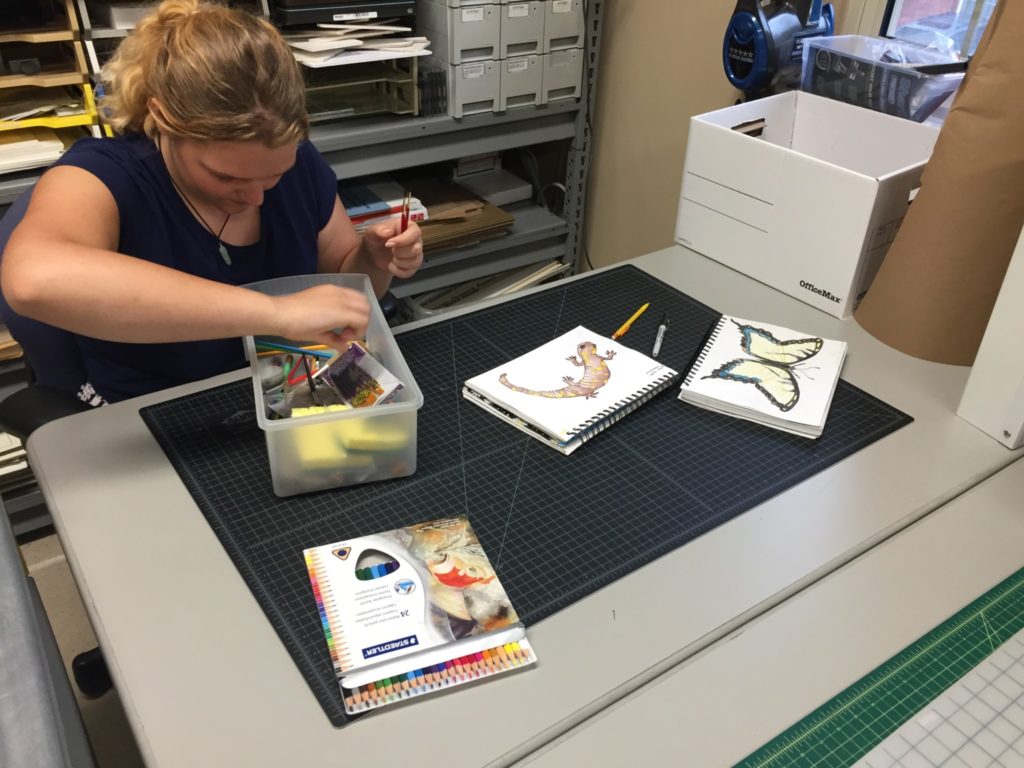My summer with the Loyal Jones Appalachian Center’s Studio began with redesigning a light show for a cloud constructed of beer pong balls. After that small design success, Chris Miller, who runs the LJAC Studio, proposed another creative project to me. His vision was to have a series of displays of beings that live in the understory of Appalachia containing information children could understand and learn from. I was on board with the idea and the search began for which critters and plants were common, interesting, and important enough to make the wall in the Appalachian Center Gallery. After consulting the many books, Google, and the Encyclopedia of Appalachia for possible wildflowers, fungi, salamanders, and other creatures from beneath the brush, we made a list of possibilities. After we finalized the decision regarding what to make, it came time to start designing. Ideas were thrown around about whether or not we should just rip graphics from the Internet and go from there. Neither of us were crazy about doing that so Chris, having seen only one sub-par sketch I had made of the cloud for the previous project, asked me if I could illustrate the critters that would be on the displays.

I met him with great hesitation. I came to Berea because my art teacher in high school had faith in my ability, but I hadn’t created anything since my senior year. I was hesitant to even begin the project because I didn’t want to be embarrassed if it didn’t turn out exactly how I wanted, or worse, realize midway through that I’m not a good artist. I agreed to draw a single salamander to start, under the condition that if I didn’t like my work we would turn towards a different direction to move forward with the project.
 I attempted to make the Spotted Salamander illustration as scientific and accurate as possible while maintaining optimal cuteness– a challenge in and of itself. My mission was to capture the realistic anatomy and colors of the critter, while also making the illustration cute and visually interesting. Photorealism was the goal, but not an attainable one. Nonetheless, Chris liked my work and encouraged me to keep going. So I spent two full weeks drawing, painting, and finishing a variety of Appalachian wildlife. By the end of those two weeks I had a twenty pages of watercolor, colored penciled, and Sharpied Appalachian wildlife ready to be scanned into Photoshop and worked with from there. Some days I hated my work, other days I was content with it. Those are just the feelings that go along with art making. The fear of it not being good enough, the frustration of trying to make something and it not looking like what you had visualized in your head, and the self-criticism alone are enough to stop anyone from being a creator. I learned that it is also possible to burn out from creating so much. It became necessary for me to take breaks from my work or I would get frustrated with everything I was making. It was certainly a challenge, but well worth it. I had no idea I could create a series of wildflowers, fungi, an assortment of salamanders, the necessary Appalachian Swallowtail butterfly, and a crayfish that all look like they belong together and are decently accurate to their realistic counterparts.
I attempted to make the Spotted Salamander illustration as scientific and accurate as possible while maintaining optimal cuteness– a challenge in and of itself. My mission was to capture the realistic anatomy and colors of the critter, while also making the illustration cute and visually interesting. Photorealism was the goal, but not an attainable one. Nonetheless, Chris liked my work and encouraged me to keep going. So I spent two full weeks drawing, painting, and finishing a variety of Appalachian wildlife. By the end of those two weeks I had a twenty pages of watercolor, colored penciled, and Sharpied Appalachian wildlife ready to be scanned into Photoshop and worked with from there. Some days I hated my work, other days I was content with it. Those are just the feelings that go along with art making. The fear of it not being good enough, the frustration of trying to make something and it not looking like what you had visualized in your head, and the self-criticism alone are enough to stop anyone from being a creator. I learned that it is also possible to burn out from creating so much. It became necessary for me to take breaks from my work or I would get frustrated with everything I was making. It was certainly a challenge, but well worth it. I had no idea I could create a series of wildflowers, fungi, an assortment of salamanders, the necessary Appalachian Swallowtail butterfly, and a crayfish that all look like they belong together and are decently accurate to their realistic counterparts.
 After illustrating, we moved on to the design phase of the project. The images were scanned into Photoshop, cropped, and thrown into a spread in InDesign. I created the layouts for the displays and finally moved past the mountainous learning curve of InDesign. I spent another week playing with the shape, color, layout, and information of the displays. We continued forward to mounting, pressing, sawing, finishing, and finally had the display together. After spending nearly a month looking at and working on these displays, I was excited to hang the newly completed foam board critters and moving onto the next project. We rearranged all of the walls of the Gallery downstairs and made a home for the wildlife on the understory of the wall. I’d like to think my coworkers welcomed the new change with open arms and hearts.
After illustrating, we moved on to the design phase of the project. The images were scanned into Photoshop, cropped, and thrown into a spread in InDesign. I created the layouts for the displays and finally moved past the mountainous learning curve of InDesign. I spent another week playing with the shape, color, layout, and information of the displays. We continued forward to mounting, pressing, sawing, finishing, and finally had the display together. After spending nearly a month looking at and working on these displays, I was excited to hang the newly completed foam board critters and moving onto the next project. We rearranged all of the walls of the Gallery downstairs and made a home for the wildlife on the understory of the wall. I’d like to think my coworkers welcomed the new change with open arms and hearts.
This project was difficult but rewarding. I learned a multitude of things I would’ve never even been curious about. For example, salamanders release toxins through their skin, eating Lillies will make you vomit until you pass out, and watercolor colored pencils are the best thing since sliced bread. My coworkers and other visitors reacted to my work with enthusiasm and encouragement, though I felt uneasy about it being on display at first. Now that the display has been up for awhile and multiple people have made positive comments about my work, I am far more proud and content with people seeing it on a daily basis.
All in all, I got paid to make art, which changed my future plans ever so slightly. Rather than following the (almost) practical and reasonable plan I had originally intended to follow, I am going to continue to pursue art and see which road the Appalachian understory might’ve led me down. The world needs artists as much as it needs teachers, lawyers, firefighters, and doctors. So thank you to the Appalachian Center for pushing me to create this summer—frogs, crayfish, mushrooms, and all—it has been well worth it.
Article Written by Magenta Palo
